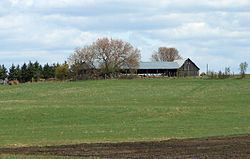Country Canada Constituted December 30, 1998 Postal code(s) J0X 1M0 Area 234.2 km² Population 1,345 (2011) Area code 819 | Region Outaouais Time zone EST (UTC−5) Highways Route 148 Local time Sunday 10:09 PM Province Québec RCM Outaouais | |
 | ||
Weather -3°C, Wind SW at 5 km/h, 71% Humidity | ||
L'Isle-aux-Allumettes is a municipality in the Outaouais region, part of the Pontiac Regional County Municipality, Quebec, Canada. The municipality consists primarily of Allumette Island (in French Île aux Allumettes), and also includes Morrison Island, Marcotte Island, and some minor islets, all in the Ottawa River north of Pembroke.
Contents
Map of L'Isle-aux-Allumettes, QC, Canada
In the past, the island and municipalities have been spelled in French in various ways:
Geography
Allumette Island is 22 kilometres (14 mi) long and 12 kilometres (7.5 mi) wide, making it the largest island within the Ottawa River along its entire course. At this point the Ottawa River has widened into a lake, called Allumette Lake, which is 52 km (32 mi) long and has a total surface area of 120 km2 (46 sq mi).
The municipality consists mostly of agricultural land. Its population centres are Chapeau, Desjardinsville, Demers Centre, and Saint-Joseph.
History
The Kichesipirini Algonquins first occupied the site in order to maintain control of trade on the Ottawa River. For this reason, Samuel de Champlain named it Isle des Algoumequins during his trip of 1613. In 1650, this native population was almost entirely exterminated by the Iroquois.
In his memoirs written during the second half of the 17th century, Nicolas Perrot made mention of the "One-Eyed Island otherwise called Allumette Island" ("Isle du Borgne autrement ditte l'Isle des Allumettes"). The name "One-Eyed" was a reference to the disability of Tessouat, an Algonquin chief in the region. The name "Allumettes" (literally meaning "matches") was first given to the rapids south-east of the island. A map from 1680 refers to these as Sault des Allumettes (Allumette Falls).
It was not until 1818 that Europeans began to settle on the island. They worked mostly as loggers or for the Hudson's Bay Company which had a fur trading post just upstream at Fort William. The preferred transport route was still the river, so most families build their homes south on the island where the church of Saint-Alphonse-de-l'Île-aux-Allumettes Parish was built in 1840. The Île-aux-Allumettes Township was formed in 1847, and its first mayor was Andrew Whelan.
An intense fire destroyed almost all the buildings in 1853 and, thereafter, the population rather settled in the northern part, on the current site of Chapeau village. In 1874, the village of Chapeau separated from the township and became an incorporated municipality, with Patrick Cunningham as the first mayor.
In 1910, the parish of Saint-Joseph-de-l'Île-aux-Allumettes was established on the eastern part of the island, leading to the formation of the Municipality of L'Isle-aux-Allumettes-Partie-Est in 1920.
On December 30, 1998, the municipality of Chapeau Village and the township municipalities of L'Isle-aux-Allumettes and L'Isle-aux-Allumettes-Part-East were regrouped into the new Municipality of L'Isle-aux-Allumettes.
UFO Landing Incident
On May 11, 1969, near Chapeau, a farmer by the name of Leo-Paul Chaput was awakened at 2 am, and witnessed a brilliant white light emanating from a flat-bottomed domed craft, resembling a French WWI military helmet. The next morning, a 32 feet (9.8 m) wide circular imprint was found in the ground, with a ring of scorched grass 2.5 feet (0.76 m) wide, containing three indentations forming an equilateral triangle, with sides 15 feet (4.6 m) long, each dent 8 inches (20 cm) wide and 3 inches (7.6 cm) deep, suggesting a "landing tripod". A second smaller circle was also found, with a ring of scorched grass, but the triangle of indentations was smaller and not equilateral. A third scorched marking, although a semicircle, contained a pile of rocks. An explanation was offered that the circles were fairy rings, but this seems unlikely as they take years to achieve such a size and the witness insisted the markings were not there the day before.
Language
Mother tongue:
